27 Iconic Korean Soups That Warm Your Soul
Korean soups represent a vibrant culinary tradition deeply rooted in comfort and healing.
Liquid meals that go far beyond simple nourishment, embodying cultural warmth and familial connections.
Robust flavors dance through carefully crafted broths, telling stories of regional ingredients and generational recipes.
Nutritional balance and emotional satisfaction merge in each carefully prepared bowl, reflecting Korea's profound food philosophy.
Hearty and soul-soothing, these soups transcend mere sustenance to become expressions of care and community.
Different regions contribute unique characteristics, creating a diverse landscape of aromatic and deeply satisfying liquid dishes.
Temperature and seasonality play crucial roles in soup selection, demonstrating the intricate relationship between food and well-being.
Dive into these 27 signature Korean soups to uncover delicious culinary treasures:
Signature Korean Soups for Every Season
Korean soups are as diverse as the seasons. Spicy, mild, clear, or creamy, each bowl brings comfort and a taste of Korea’s rich culinary landscape.
Gamjatang
Gamjatang is a robust Korean pork spine stew packed with intense flavors and nutritional power from tender meat, soft potatoes, and spicy seasonings.
Korean workers in Incheon originally developed this hearty dish as a filling meal during long construction shifts.
Simmered with bean paste, chili powder, and garlic, the stew creates a complex taste profile that warms the body and soul.
Korean restaurants nationwide now serve gamjatang as a popular comfort food and hangover remedy.
Sesame leaves typically garnish the top of the dish, adding fresh herbal notes.
Cold soju often accompanies gamjatang, enhancing its rich taste experience.
Modern versions have spread across Asia, Europe, and the United States, introducing global diners to this traditional Korean specialty.
Yukgaejang
Yukgaejang spearheads Korean cuisine as a fiery, robust beef soup brimming with intense flavor and complex ingredients.
Simmered beef brisket forms the soup's hearty foundation, complemented by scallions, gosari, bean sprouts, and leeks.
Chili paste, soy sauce, sesame oil, and garlic create a powerful seasoning profile that warms you from within.
Traditional recipes often include glass noodles for added texture and substance.
Korean families typically enjoy this soup during cold winter months as a comforting meal.
Home cooks carefully balance spices to achieve the perfect heat level.
Miyeokguk
Miyeok-guk is a nutritious South Korean seaweed soup celebrated for its healing properties and deep cultural significance.
Korean women traditionally consume this soup after childbirth to restore strength and replenish essential nutrients from wakame seaweed.
Generations have embraced this comforting dish as a symbol of maternal care and wellness.
Sea vegetables provide powerful minerals and vitamins that support postpartum recovery.
Protein variations like beef, prawns, oysters, mussels, or tofu enhance the soup's flavor and nutritional profile.
Sesame oil and soy sauce create a rich, savory broth that warms the body and soul.
Koreans often serve miyeok-guk with steamed rice and accompanying side dishes.
Birthday celebrations also feature this meaningful soup as a reminder of maternal love and personal growth.
Kimchi-Guksu
Kimchi-guksu is a spicy Korean noodle soup bursting with tangy fermented kimchi flavors and complex heat from gochujang.
South Korean home kitchens cherish this simple yet vibrant dish featuring wheat flour noodles swimming in rich vegetable stock.
Cooks quickly boil somyeon noodles until perfectly chewy and tender.
Hot stock cascades over the noodles in individual serving bowls.
Bright red kimchi and fiery gochujang create a zesty sauce that coats each strand.
Scallions and nori sheets add fresh green crunch and umami depth to the soup.
Sesame oil and seeds provide nutty undertones that balance the dish's intense spiciness.
Samgyetang
Samgyetang emerges as a Korean summer soup featuring a whole young chicken stuffed with ginseng and rice, delivering powerful health benefits through its medicinal ingredients.
Ginseng plays a crucial role in this dish, known for lowering blood sugar and strengthening the body's immune system during hot months when people experience nutrition deficits from excessive sweating.
Korean diners appreciate its milder herbal flavor compared to other medicinal soups, making it an accessible wellness-focused meal.
Restaurants often serve the soup with a small bottle of insangju ginseng alcohol, which is believed to enhance physical stamina.
Traditional preparation involves slowly simmering the chicken to create a rich, nourishing broth that infuses the meat with healing properties.
Young chickens are preferred for their tender texture and ability to absorb the ginseng's nutrients effectively.
Small amounts of garlic and other seasonings complement the soup's subtle yet robust profile.
Prices remain affordable, contributing to its widespread popularity across South Korea as a summer wellness dish.
Kalguksu
Kalguksu are traditional Korean hand-cut wheat noodles swimming in a deeply flavorful broth that celebrates South Korean culinary comfort.
Seafood versions reign supreme, featuring shellfish, dried anchovies, and kelp in a rich liquid base that warms hungry diners.
Skilled Korean home cooks slice noodles by hand, creating uneven edges that distinguish this dish from machine-made alternatives.
Chicken, mushroom, and spicy variations expand the kalguksu family, offering diverse flavor profiles for different tastes.
Regional ingredients and preparation methods create subtle differences across South Korean provinces.
Summer rainy seasons and cool windy days make kalguksu especially popular among locals seeking hearty meals.
Hand-cutting wheat flour and egg noodles requires precision and practice passed through generations.
Each bowl connects Korean culinary traditions with simple, nourishing ingredients that tell a story of comfort and home.
Galbitang
Galbitang is a luxurious Korean beef short-rib soup slow-cooked for hours to create a rich, deeply flavored broth that melts in your mouth.
Beef ribs simmered with whole radish transform into tender meat swimming in a clear, savory liquid seasoned with traditional Korean ingredients like sesame oil, scallions, and garlic.
Expensive beef cuts make this soup a special-occasion dish often served at weddings and banquets.
Home cooks meticulously boil the ribs for 4 to 5 hours to extract maximum flavor and achieve perfect tenderness.
Ground pepper and soy sauce enhance the soup's complex taste profile.
Salt and sesame seeds provide final seasoning touches that elevate the dish.
Closely related to seolleongtang, another bone-based Korean soup, galbitang represents comfort and celebration in Korean cuisine.
Korean families treasure this nourishing soup as a symbol of culinary tradition and shared meals.
Seolleongtang
Seolleongtang is a rich, milky white bone soup emerging from South Korean culinary traditions that simmers cow bones, feet, head, organs, brisket, and shank for hours to create an intensely nourishing broth.
Royal origins trace back to King Seonjong's need to feed masses during a farming deity worship ritual where cow sacrifices inspired the dish's creation.
Korean families embrace this warming soup especially during cold winter seasons as a nutritious meal.
Slow cooking transforms raw ingredients into a creamy, protein-packed liquid with deep, complex flavors.
Restaurant and home cooks carefully boil ingredients to extract maximum marrow and collagen essence.
Traditional preparation requires patience and precise temperature control.
Salt and green onions typically garnish the soup before serving.
Korean diners consider this soup a comforting winter staple that connects generations through its simple yet profound preparation.
Dwaeji Gukbap
Dwaeji gukbap is a hearty South Korean soup born from wartime necessity, originating among North Korean refugees during the 1950s Korean War.
Pork bone broth forms the rich base of this rustic dish, blended with soy sauce, miso, rice wine, and sesame oil.
Refugees initially crafted the soup with beef, transforming it into a comforting meal during challenging times.
Busan embraced dwaeji gukbap, making it a regional specialty that soon spread across South Korea.
You can customize the soup with an array of side ingredients like rice, shrimp, onions, noodles, kimchi, garlic, and green peppers.
Each bowl offers a deeply satisfying experience, particularly appreciated by women recovering from childbirth.
Modern diners often enjoy dwaeji gukbap as a companion to alcoholic drinks.
South Korean restaurants now celebrate this humble soup as a beloved national comfort food.
Manduguk
Manduguk is a soul-warming Korean dumpling soup featuring crescent-shaped mandu stuffed with seasoned beef and vegetables swimming in a rich anchovy or beef broth.
South Korean families traditionally serve this comforting dish during Lunar New Year celebrations, believing happiness resides inside each carefully crafted dumpling.
Shiitake mushrooms and onions add depth to the broth, while occasional rice cake slices provide extra texture.
Home cooks carefully fold mandu by hand, ensuring each dumpling carries generations of culinary tradition.
Sliced scallions and delicate egg strips garnish the soup, creating visual appeal and additional flavor layers.
Kimchi and pickled vegetables accompany the soup as classic side dishes.
Small portions of manduguk often mark special family gatherings, symbolizing warmth and shared cultural connection.
Muguk
Seolleongtang is a classic Korean beef bone soup renowned for its milky-white broth created by simmering ox bones for hours until the marrow and collagen dissolve into a rich, creamy liquid.
Korean restaurants traditionally serve this comforting soup with thin slices of beef, tender radish pieces, and green onions as garnish.
Restaurants often provide seasoning options like salt, black pepper, and chopped scallions so diners can customize their bowl's flavor profile.
Origins of the soup trace back to the Joseon Dynasty, where it was a popular street food among working-class communities in Seoul.
Home cooks and restaurant chefs carefully prepare the broth by slowly boiling beef bones, which releases essential nutrients and creates its signature opaque white color.
Korean families consider seolleongtang a nourishing meal that provides warmth and sustenance during cold winters.
Restaurants typically accompany the soup with kimchi and rice, creating a complete and satisfying meal.
Sundaeguk
Sundae gukbap represents a bold Korean street food soup featuring blood sausage as its star ingredient.
Korean street vendors expertly craft this robust soup by combining sliced sundae with rich broth, assorted offal, and tender noodles.
Blood sausage brings deep umami flavor and unique texture to the dish.
Restaurants and street stalls across South Korea serve this warming meal as a satisfying comfort food.
Traditional preparation involves simmering sundae and organ meats in a savory broth.
Vegetables add freshness and balance to the intense meat components.
Rice can accompany the soup or be mixed directly into the broth.
Spicy seasonings and garnishes enhance the complex flavor profile of this hearty street cuisine.
Tteokguk
Tteokguk are traditional Korean New Year rice cake soup symbolizing good luck and new beginnings for diners celebrating annual transitions.
Korean families prepare this special soup using clear beef, seafood, or kelp broth as a foundational element.
Thin, oval-shaped rice cakes called tteok float inside the warm soup as primary ingredients.
Delicate garnishes like pan-fried egg ribbons, sliced scallions, and shredded seaweed enhance the soup's visual and flavor profile.
Meat strips often complement the broth's rich texture and taste.
Koreans consider eating tteokguk a symbolic ritual marking personal aging and welcoming positive fortune for upcoming years.
Each spoonful represents hope and renewal for individuals and families.
Rice cakes symbolize prosperity and longevity in Korean cultural traditions.
Kongguksu
Kongguksu are Korean cold noodles swimming in creamy soy milk broth, a summer staple that delivers refreshing comfort through pure simplicity.
Summer temperatures spark Korean diners' passion for this protein-rich noodle dish made with ground soybeans and delicate somyeon noodles.
Traditional preparation involves carefully cooking and blending soybeans into a smooth, white liquid that becomes the dish's signature base.
Sesame seeds and occasional nuts enhance the broth's nutty undertones and nutritional profile.
Cool cucumber strips and ripe tomato slices typically garnish the noodles, adding crisp texture and fresh visual appeal.
Nutritionists praise kongguksu for its high protein content and cooling properties during hot months.
Home cooks across Korea treasure this easy-to-prepare meal that balances subtle flavors and nutritional benefits.
Summer kitchens often feature this lightweight yet satisfying dish as a go-to meal for quick nourishment.
Janchi Guksu
Janchi guksu embodies Korean comfort food through its simple yet elegant wheat noodle soup featuring a clear anchovy or beef broth that delights diners with its clean, subtle flavors.
Somyeon wheat noodles form the base of this traditional dish, creating a light and satisfying meal.
Chefs prepare the broth with care, often using anchovy or beef as a foundational flavor.
Thin egg slices, fresh seaweed, crisp carrots, earthy shitake mushrooms, and tender zucchinis add visual appeal and textural complexity to the bowl.
Yangnyeomjang, a spicy soy sauce-based dip, accompanies the noodles and provides an extra punch of flavor.
Korean families frequently enjoy janchi guksu during special gatherings and celebrations.
Home cooks treasure this dish for its ease of preparation and comforting warmth.
Each ingredient contributes to a balanced, nourishing experience that represents Korean culinary traditions.
Altang
Myeongnan-jjim is a spicy Korean stew centered around fresh pollack roe served in a fiery hot broth that highlights seafood's rich umami flavors.
Korean home cooks traditionally prepare this dish with dashi-based stock seasoned with gochujang paste for intense heat and depth.
Pollack roe emerges as the star ingredient, creating a vibrant and luxurious seafood experience.
Sliced daikon radish adds crispness and balance to the intense flavor profile.
Scallions and bean sprouts contribute freshness and texture to the stew.
Tofu sometimes joins the mix, providing additional protein and softness.
Sujebi
Janchi guksu are Korean wheat noodles swimming in a delicate seafood broth traditionally crafted with anchovies and dry seaweed.
Modest street vendors and home kitchens across South Korea serve this simple yet satisfying dish as a light meal or side course.
Thin wheat noodles form the foundation of the soup, creating a silky smooth texture that absorbs the subtle marine flavors.
Scallions, potatoes, and optional kimchi add depth and crunch to the broth's nuanced profile.
Fishermen and coastal communities first developed this unassuming recipe as a quick, nourishing meal between work shifts.
Korean families often prepare janchi guksu during celebrations and gatherings, symbolizing happiness and prosperity.
Diners typically season the soup with additional condiments like gochugaru red pepper flakes or soy sauce.
Soft, translucent noodles and rich umami broth make this dish a comforting staple of Korean cuisine.
Kongnamul Gukbap
Kong-namul guk spotlights South Korean comfort through a simple yet nourishing soup featuring delicate soybean sprouts swimming in a mild, savory broth.
Korean households frequently prepare this warming dish as an affordable and nutritious meal with regional variations across different provinces.
Fresh soybean sprouts provide a subtle crunch and mild nutty flavor that distinguishes the soup from other traditional Korean broths.
Minimal ingredients typically include soybean sprouts, garlic, green onions, and a light seasoning of salt and pepper.
Home cooks often add optional protein like egg or beef to enhance the soup's nutritional profile.
Traditional preparation involves simmering sprouts in water with aromatic seasonings until they reach a tender consistency.
Jeonju region claims special recognition for perfecting this humble soup's balanced technique and flavor profile.
South Korean families consider kong-namul guk a staple comfort food that reflects home cooking's straightforward elegance.
Memil Guksu
Memil guksu are South Korean buckwheat noodles swimming in a savory broth that celebrates Korea's culinary simplicity and regional ingredients.
Cold or hot versions highlight the noodles' nutty flavor and smooth texture.
Buckwheat noodles form the dish's core, complemented by delicate eggs and fresh green onions.
Seaweed garnishes add maritime depth to each serving.
Traditional preparation involves boiling noodles in a gentle broth made from guksijangguk and Japanese hondashi.
Home cooks often serve this dish as a quick, nutritious meal.
Winter and summer both welcome this versatile noodle soup.
Kongnamul Guk
Kongnamul guk represents a classic South Korean soup featuring soybean sprouts as its core ingredient.
Anchovy-based broths provide the most traditional flavor profile for this simple yet nutritious dish.
South Korean families frequently prepare this soup as a quick, comforting meal with minimal ingredients.
Red chili flakes often enhance the broth's taste, adding a sharp spicy dimension.
Water can substitute anchovy stock when preferred, making the soup versatile and accessible.
Light and cleansing, kongnamul guk serves as a popular side dish in Korean cuisine.
Salt and green onions typically complete the basic preparation.
Chueotang
Mueo-eo guk is a spicy Korean soup brimming with robust mudfish flavor and intense regional variations.
Seoul cooks prepare this soup using whole mudfish, while Namwon specializes in ground fish preparations.
Chili paste, soybean paste, and ginger form the soup's foundational seasonings.
Green vegetables like mustard greens, scallions, and cabbage enhance its complexity and nutritional profile.
Traditional recipes highlight the fish's unique texture and sharp, distinctive taste.
Korean home kitchens often serve this soup as a warming winter meal.
Regional differences showcase the dish's adaptability across different Korean provinces.
Small touches of fresh ingredients elevate the soup's overall character.
Naengguk
Naengguk are refreshing South Korean cold soups designed to cool you down during sweltering summer months.
Korean families traditionally prepare these soups with crisp vegetables, seaweed, and chilled water mixed with vinegar for an instant temperature drop.
Most recipes feature cucumber, spring onions, and garlic as primary ingredients.
Cold water serves as the base liquid, creating an instant cooling effect.
Wakame or nori seaweed adds depth and authentic maritime flavor to each bowl.
Summer heat makes these soups especially popular across South Korean households.
Vinegar provides a tangy undertone that complements the vegetables' freshness.
Mussel Soup (Honghap Tang)
Honghap tang sparkles as a robust Korean seafood soup brimming with fresh mussels and intense oceanic flavors.
South Korean coastal regions developed this hearty broth using simple, fresh ingredients like plump mussels, sharp onions, and spicy hot peppers.
Fishermen traditionally prepared this warming soup after long days at sea, extracting maximum flavor from minimal components.
Raw mussels simmer until shells naturally open, releasing rich juices that transform clear water into a creamy, golden liquid.
Sea salt and fresh garlic enhance the soup's deep umami profile, creating a complex maritime experience.
Home cooks typically garnish the soup with sliced scallions for additional freshness and visual appeal.
Small bowls of steaming honghap tang offer quick, nourishing comfort during cold weather or as a light meal.
Oxtail Soup (Kkori Gomtang)
Kkori gomtang are rich, creamy South Korean oxtail soup renowned for its deeply nourishing bone broth simmered for hours until milky white.
Generations of Korean families have treasured this hearty soup as a comforting winter meal packed with collagen and minerals.
Home cooks meticulously prepare the soup by slowly boiling oxtails with precise techniques that extract maximum flavor and nutrients.
Traditional preparation involves carefully skimming foam during extended cooking to ensure a clear, smooth broth.
Tender oxtail meat falls gently from bones into the silky liquid, creating a luxurious texture.
Garlic, salt, and peppercorns enhance the broth's complex flavor profile.
Chopped scallions garnish the soup, adding a fresh green contrast to the creamy white base.
Warm bowls of kkori gomtang offer Korean diners a deeply satisfying and nutritious meal that connects them to culinary heritage.
Onmyeon
Onmyeon is a comforting Korean noodle soup featuring a rich beef broth and tender ingredients that warm you from the inside out.
Korean families traditionally prepare this hearty dish with slow-simmered beef, creating a deeply flavorful base.
Somyeon noodles float in the savory liquid, complemented by whisked egg strips and softened zucchini.
Dried mushrooms add an earthy depth to the broth, which gets seasoned with soy sauce and salt.
Scallions and garlic infuse additional layers of taste into the soup.
Home cooks carefully slice beef after slow-cooking it in water, ensuring maximum tenderness.
Each ingredient is separately prepared to maximize its individual flavor profile.
Fried vegetables and carefully cooked noodles complete this satisfying meal that represents Korean home cooking at its best.
Beondegi Soup
Beondegi soup embodies Korean culinary adventurousness through its unique protein source of silkworm pupae, a traditional street food prized for nutritional density and intense umami flavors.
Korea's distinctive soup transforms these insects into a savory delicacy by marinating them in sweet soy sauce before slow-boiling in water.
Street vendors and home cooks carefully select fresh pupae, ensuring optimal texture and taste.
Rich in protein and minerals, beondegi offers substantial nutritional benefits beyond its bold sensory experience.
Earthy aromas distinguish this soup, making it instantly recognizable from a distance.
Generations of Koreans have enjoyed this unconventional dish as a hearty winter comfort food.
Silkworm pupae provide a crunchy yet tender element that surprises first-time tasters.
Cold Seaweed-Cucumber Soup (Miyeok-Oi-Naengguk)
Miyeok-oi-naengguk represents a refreshing Korean cold soup bursting with oceanic flavors and crisp vegetable textures.
South Korean summers welcome this chilled dish as a cooling antidote to intense heat.
Wakame seaweed forms the soup's signature ingredient, lending a deep maritime essence and bright green color.
Fresh cucumbers and cherry tomatoes add vibrant crunch and sweetness to each spoonful.
Hot peppers provide a subtle spicy kick that balances the soup's cool temperature.
Scallions, garlic, and onions contribute layered aromatic notes throughout the broth.
Sesame seeds sprinkled on top create a nutty finish to this traditional summer recipe.
Salt, sugar, and white vinegar combine to create a perfectly balanced seasoning that enhances every ingredient.
How Are Korean Soups Different From Japanese or Chinese Soups?
Korean soups have distinct characteristics that set them apart from their Japanese and Chinese counterparts, shaped by local ingredients and culinary traditions:
Chinese soups vary widely, from clear, light broths to thick, herbal medicinal soups that focus on health benefits.
Korean broths are usually richer, sometimes simmered with anchovies, kelp, or beef bones for a deeper flavor.
This combination of bold seasoning, hearty ingredients, and rich broths defines the unique identity of Korean soups.
Can Korean Soups Be Eaten Cold?
Yes! Several Korean soups are traditionally served cold, especially during hot summer months. For example, naengguk (cold vegetable soups) and mul naengmyeon (cold buckwheat noodle soup) provide refreshing, tangy flavors that cool the body and stimulate the palate.
These chilled soups highlight fresh, crisp ingredients and balance spicy or fermented components, offering a unique dining experience distinct from warm Korean soups.

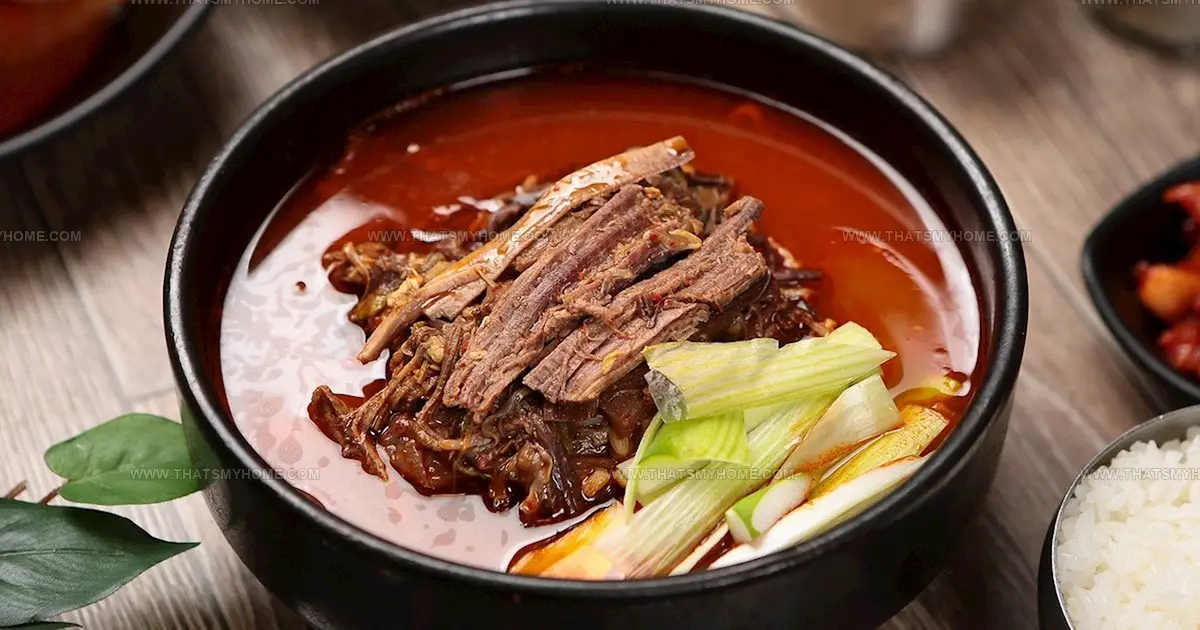
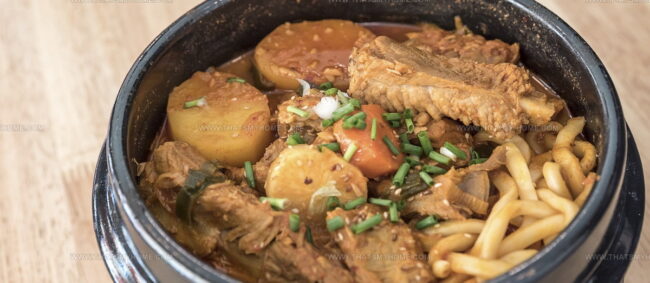
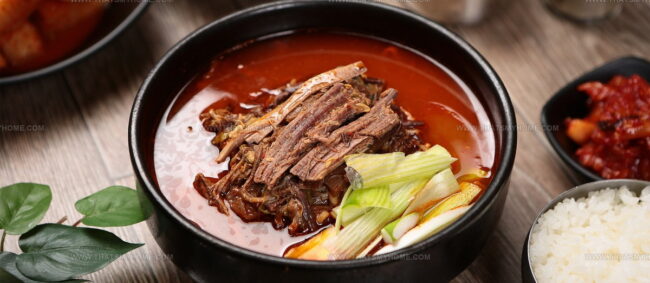
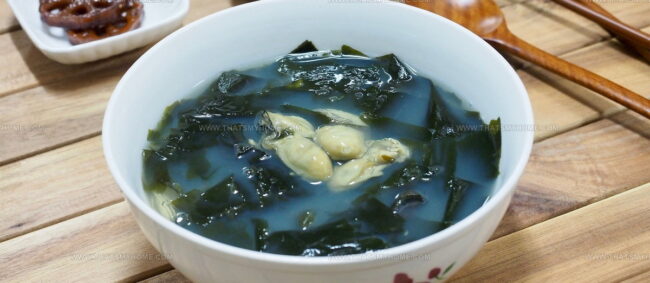
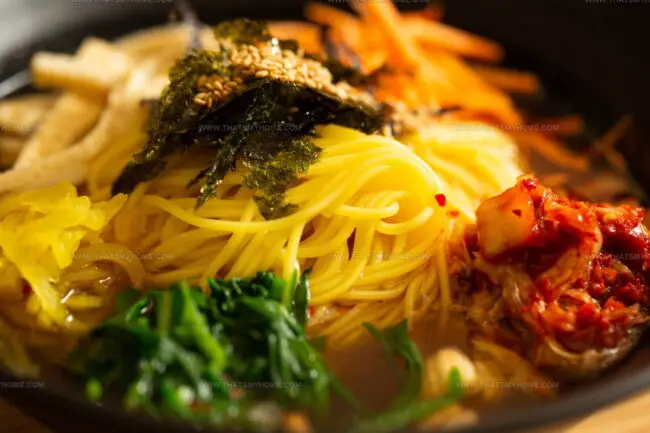
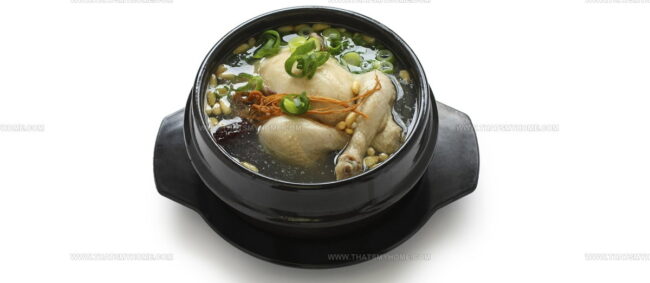
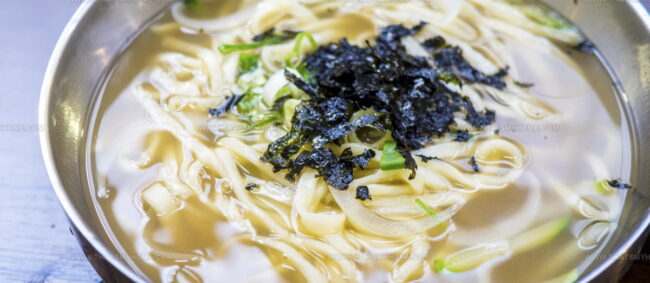
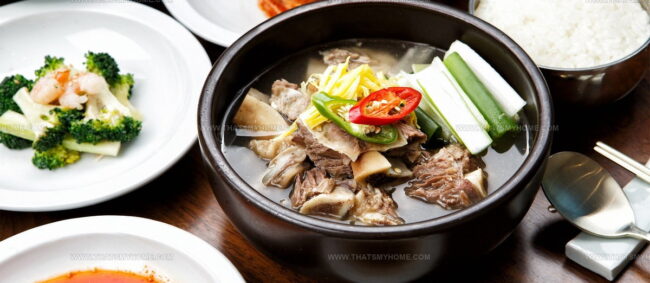
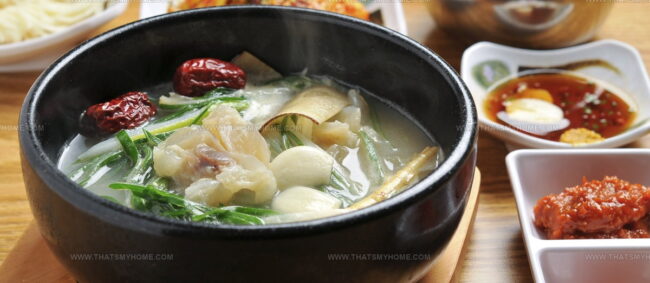
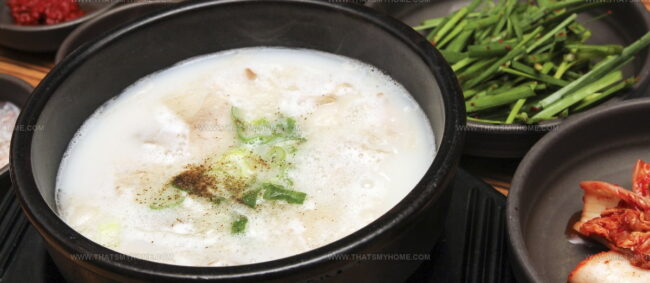
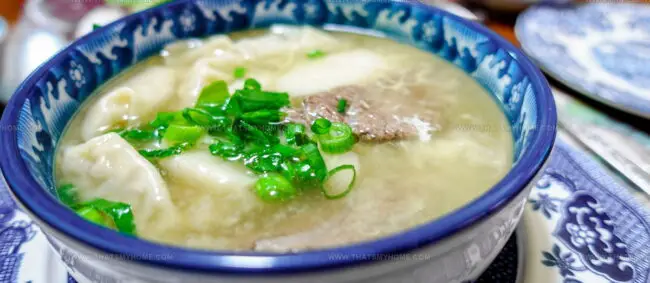
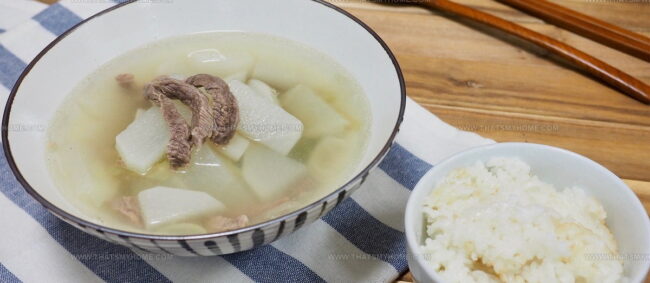
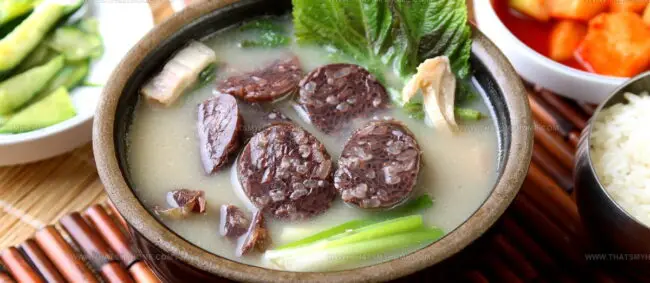
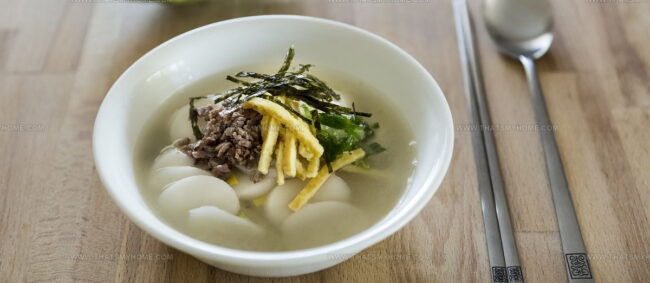
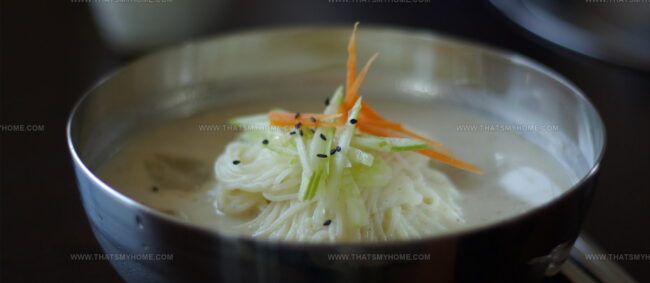
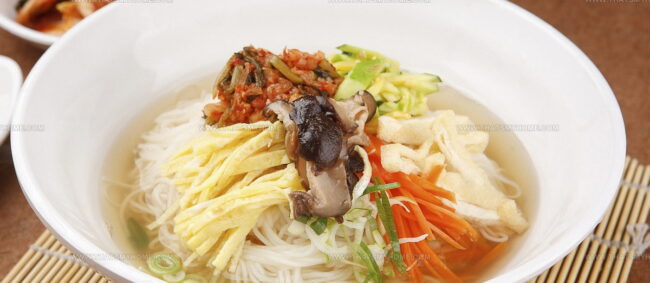
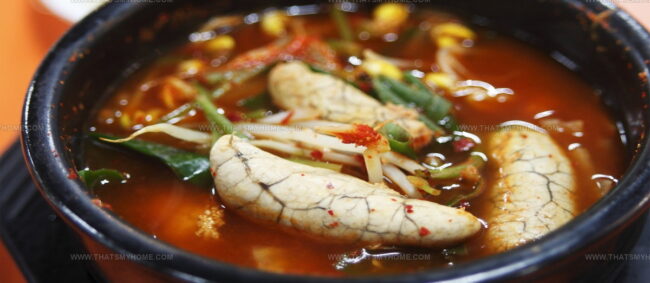
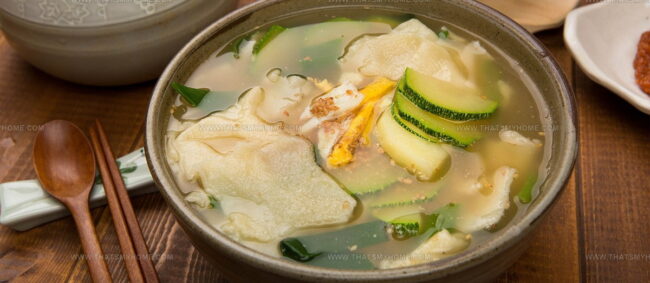
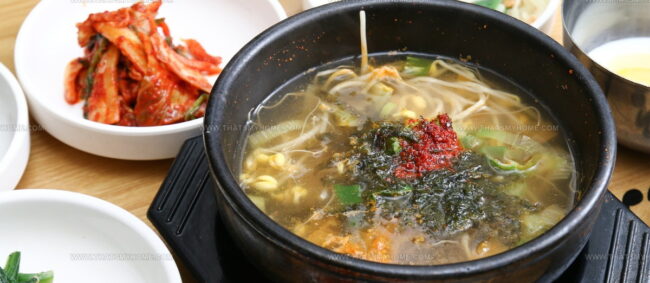
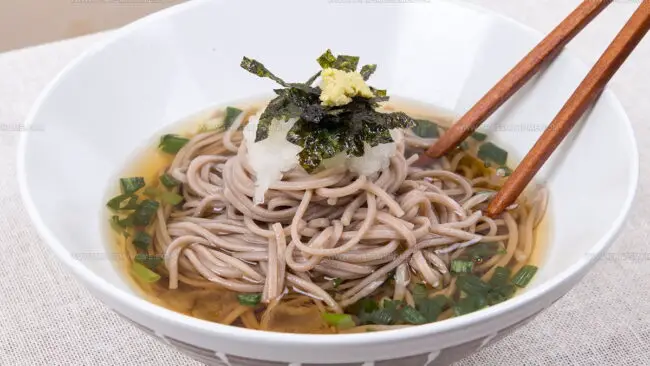
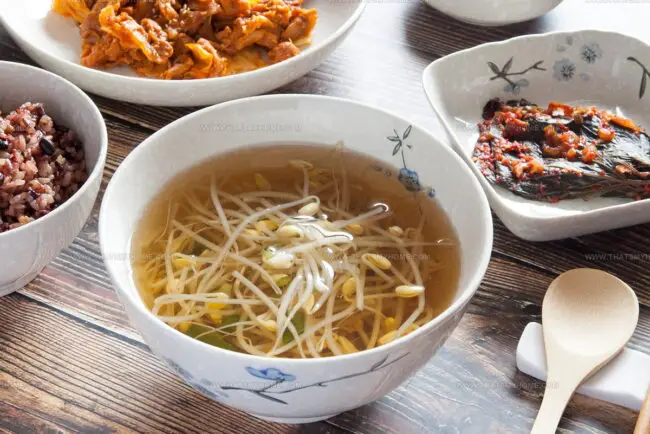
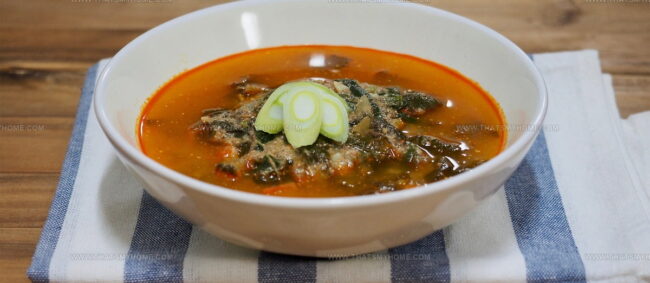
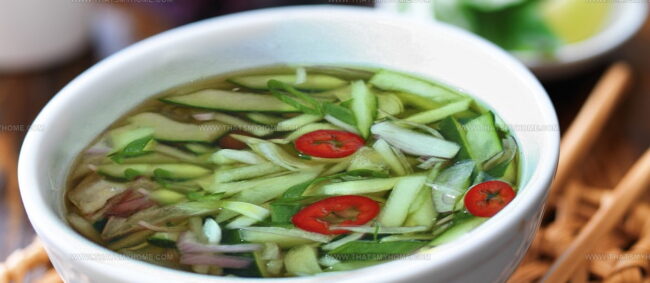
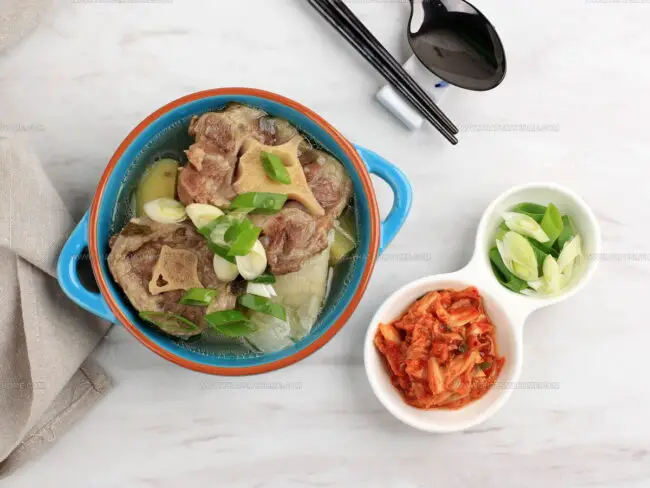
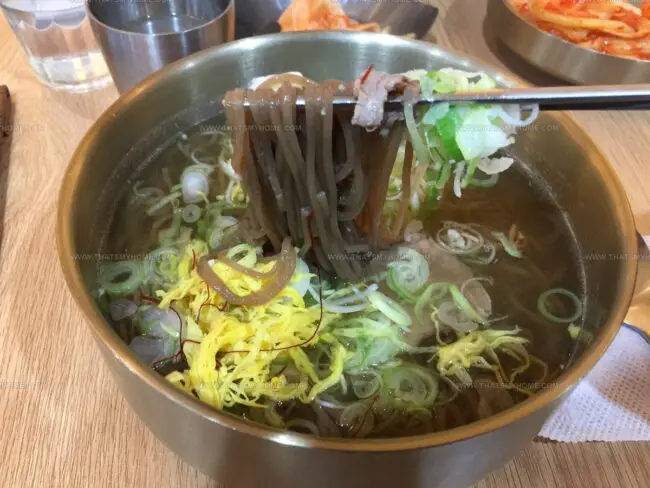
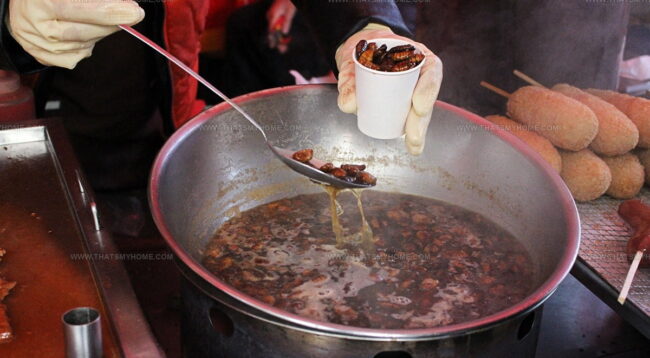
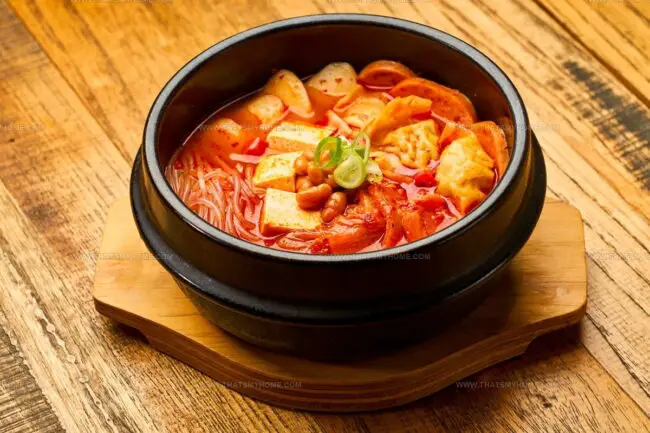
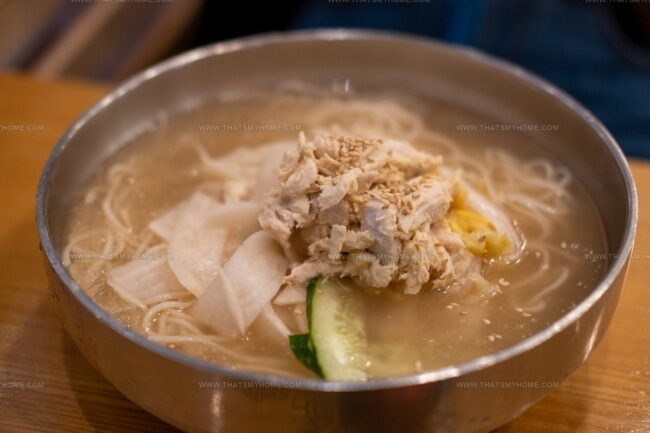
Mary Ellen
Founder, Pastry Chef & Recipe Developer
Expertise
Education
Savannah Technical College
Mary Ellen is the heart and soul of thatsmyhome.com. As the founder, pastry chef, and recipe developer, she refined her skills at Savannah Technical College with an Associate of Applied Science in Culinary Baking & Pastry Arts.
Mary blends classic techniques with modern twists to make artisanal breads, beautifully crafted pastries, and desserts full of unique flavor. Her passion is evident in every recipe, and she enjoys sharing her expertise through hands-on pastry workshops and insightful articles in local culinary magazines.